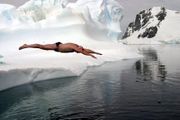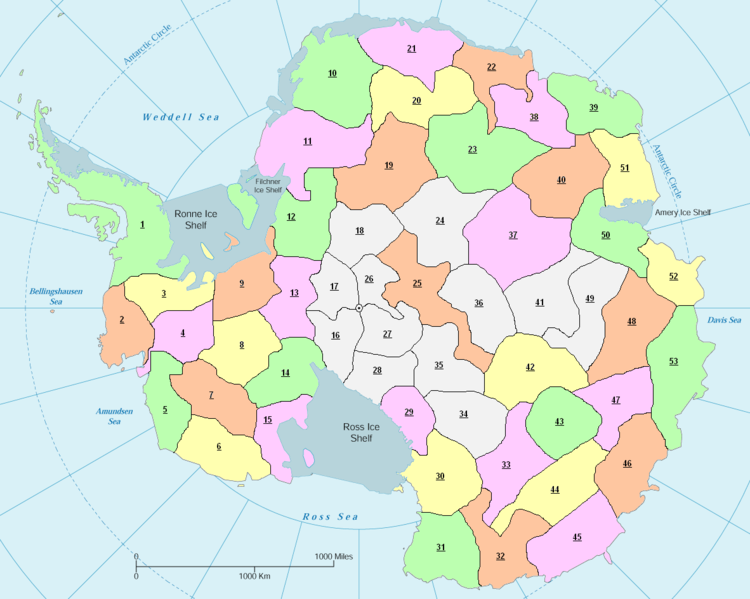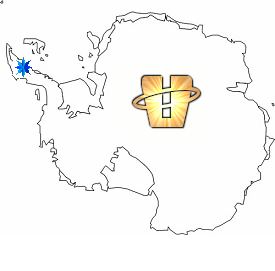Region/Antarctica
Antarctica 
|
||
|---|---|---|
| Founder | Joop | |
| WA Delegate | The Voltarum | |
| Members | 56 | |
| - | of which WA | 12 |
| Regional population | ||
| - | 2014 estimate | 505 billion |
| GRP | N/A | |
| Regional HDI | 0.540 medium |
|
| Region page Antarctica |
||
| NSTracker Antarctica |
||
Antarctica is the original Antarctic region in NationStates, and along with Antarctic Oasis one of the largest regions in NS claiming an Antarctic homeland. Once a dedicated and active defending region, it is now rather laid back and quiet. The people of Antarctica are known as Antarcticans, while the word Antarctic is usually used as an adjective for other nouns.
Contents
Quick Regional Basics
"Omnia mutantur, nos et mutamur in illis"
"All things are changing, and we are changing with them."
Antarctica is an ancient, free, democratic, open region surrounding the South Pole. It is a region of rugged individualism committed to national sovereignty, Space Weapons, Polar Bears, Olympics and Democracy.
Antarctica is a very old region, founded in early 2003 by Joop. From early on, Antarctica was a region devoted to defending regions from invasion. Today, it is a quiet region that continues its role in defending other regions as a member of the FRA, and one that still occasionally gets red faced and agitated at the World Assembly and its endless supply of red tape and idiocy.
- Former Original Member, Defender Security Alliance
- Regional Currency: Polar Crown (optional)
- Current General of the Grand Army: General Rico Meridius of Penguvia
- Regional Holidays:
- September 21st, Antarctica Day, marking the traditional founding of the Antarctica Region.
- December 21st, Festival of the Sun, marking 24 Hours of daylight below the Antarctic Circle.
- Record Population: 131 (December 2011)
Regional Trends
Antarctica is a large region, with a bustling and busy community, numbering 56 nations and only 12 World Assembly Members.
In Antarctica, denizens scatter at the sight of strangers and are careful to keep carefully blank faces when approached. Political freedom does not exist. The region is recognized as an extreme dictatorship. The economy of the region exists only in the imaginations of its members. Income taxes are unheard of amongst the denizens of the region. The economies of nations in the region tend to be dominated by the private sector, with on average only -1% of the economy comprising the public sector. Commerce is low priority for governments, accounting for an average of -1% of public expenditure, although commerce is generally seen as a source of tax revenue.
Denizens of the Antarctica are poorly educated, with rampant illiteracy. Criminality is rife within the region, with law enforcement struggling to cope. Governments allocate a meagre -1%, on average, of their budgets to law and order. Denizens have small defense forces. Public transport is an afterthought, with only -1% of total government budgets in the region being devoted to it.
Governments in Antarctica find themselves in a constant state of disarray, with very little co-ordination, only -1% on average of government budgets being devoted to Administration. Some government provision is made for healthcare, but at an average of only -1% the provision for healthcare in the region is paltry. Welfare in the region is minimal, with only a small amount of expenditure being devoted to spending on social security. Spirituality is a moderate priority of governments within the region, with-1% of government budgets being devoted to Spirituality.
Social inequality is rife amongst the nations within Antarctica. The environments of the nations in the region are almost universally appalling.
Regional History
Founding and the Time of Davisia
The citizens of Joop founded the region of Antarctica at some point in early 2003. Unfortunately for all involved, one of Joop's citizens devoured all recorded history of said founding. Thus, the official celebration of Antarctica's founding is celebrated on the Autumnal Equinox, September 21st, since it marks the start of a majority of sunlight, something very important to Antarctica.
Antarctica quickly grew in the fledgling world of NationStates, attracting all sorts of nations. One of these first settlers was the nation of Davisia. A strong nation in all aspects, Davisia quickly joined with Joop and the nations and one time delegates of Drakma, Independent Antarctica, Werewolf in Silver, Alakon, and Andinia in guiding the young region. Together, they established the guidelines Antarctica still holds today: national sovereignty, democracy, and not taking crap from the then-UN. In addition, Joop established that Antarctica was going to be active in the defending world. Antarctica was one of the first nations to join the ADN, with Joop serving as council President. Davisia eventually was elected as delegate and began making the first maps of the region. Antarctica became a premier region in the world of NationStates, and participated in many defensive operations through the ADN.
A Time of Instability and The Time of Calorom
This golden age of the region lasted for only a year. In September 2004, Davisia left the world of Nationstates, creating a power vacuum for the regional delegate position. Nations from outside the region attempted to win the delegacy of the popular region, but Joop's gentle hand focused the long-time residents into choosing a new delegate. The nations of Calorom, Thallos, and Kaiton were the popular leaders to succeed Davisia, and all three were delegates at one point. In the end, Calorom was elected and held the delegate position. As Calorom had supplied the General to the Grand Army of Antarctica, Thallos was then chosen to succeed Calorom at this position. The Voltarum assumed Davisia's role as cartographer.
Though the region was still popular, it did not grow like other regions did at the time. This, along with other factors, led to Antarctica taking more of a back burner in the ADN. Calorom was one of the most dedicated defenders in the region; now that he was delegate he could no longer leave and defend. Joop resigned from his role in the ADN, and grew more quiet. Other founding residents of Antarctica, such as Mount Erebus, Drakma, Bunny Landia, Japanese Antarctica, and Militant Pingweeners, were overtaken by polar bears. The popularity of Antarctica started to decline.
The Time of The Voltarum and the Death of Joop
Calorom's reign as UN delegate went relatively uneventful, although Vastiva did hold the delegate position for a brief time as well. Like his predecessor, however, Calorom announced he was stepping down as delegate in late August 2005. This time, there were much fewer candidates to replace him. Regional population had dipped to around only 50 nations, and Antarctica was not on the international stage as prominently in the past, so those outside the region did not attempt to interfere. On September 25, 2005, region cartographer The Voltarum was elected the new UN delegate.
Little changed for the first 6 months of The Voltarum's term. Polar bears eventually over ran Calorom, however, and soon after long time Antarcticans Kaiton and Thallos were overcome as well. Luckily, new blood had emerged to take leadership roles in the region. Pengwiniah launched a new communication network and replaced Thallos as General of the Grand Army. Sup with Bates led a new group of active defenders to continue to support the ADN.
Then, in late spring 2006, Joop closed its borders and ceased all communication with Antarctica. Thought at first to of succumbed to polar bears, it was eventually decided that Joop was just sleeping for a bit. With no founder, Antarctica was thrust into a precarious position: a stout and old defending region that was suddenly ripe for invasion. Luckily, the tireless work of Pengwiniah, Sup with Bates, and the other defenders in the ADN kept a close watch on potential invasions, and several meek attempts were thwarted easily.
The most dangerous time came in July 2006, when The Voltarum advertised a bit too heavily about a national party. With the whole of The Voltarum in a drunken stupor for nearly two weeks, invaders throughout NationStates attempted a daring and large invasion. The Grand Army was deployed, and with help from the ADN, invasion was narrowly averted. Apologizing for the lapse in judgment, The Voltarum returned to active status and the crisis was finally over. Though many more minor attempts of invasion occurred the rest of the year, none were as nearly as dangerous.
The following months saw a growth in Antarctica. The new and huge nations of Ap0calypse and H2SO4 emigrated to the region and brought more prominence to the region. The result was a ballooning of growth to a size that hadn't been seen in the region since 2003. By fall of 2006, Antarctica topped 100 nations, setting its (recorded) record of 113 nations a short time later.
The Return of Joop
Relief of potential invasions arrived in February 2007 when Joop opened up its borders once again and became Antarctica's founder. Since his return, Antarctica has settled into a somewhat quiet role in the NationStates world. In 2007, the ADN officially changed its name to the DSA, a reorganization that proved effective for a time. Eventually, however, the organization closed its doors. Under Pengwiniah's leadership, Antarctica has taken part in other defender alliances, such as SIREN and the FRA, both of which have now closed their doors.
Overall, however, these last 10 years have seen little change. Today, Antarctica has grown much quieter and smaller. The Voltarum has remained delegate, transitioning to the World Assembly. Pengwiniah has remained in control of the Grand Army, and Joop has remained an active and diligent founder. Today, new nations continue to make Antarctica one of the most successful and storied regions in the NationStates world.
Map
Changes to this map should not be made by anyone except the geographer of Antarctica. THIS MAP AND CENSUS IS NO LONGER BEING UPDATED HERE. CONSULT THE ANTARCTICA REGION AND FACTBOOK
| 01. The Voltarum | 12. Hialti | 23. | 34. | 45. Super Pixeled Penguins |
| 02. Athani | 13. Sisu Arshu | 24. Zoeannistani Antarctica | 35. | 46. Ap0calypse |
| 03. Hedjtep | 14. Sisu Pangea | 25. Jittersamhay | 36. Antonadanesian Antarctica | 47. |
| 04. Elbow Surprise | 15. Oceanus | 26. | 37. Cekoviu | 48. Toneor |
| 05. Karendar | 16. Zadtsland | 27. | 38. Xmara | 49. |
| 06. Saliba | 17. Argentine Antarctica | 28. Antarctic Circle | 39. Vastivan Alaska | 50. Ancient Antarctica |
| 07. PopDiv | 18. | 29. Miemalkonnen | 40. Beandogs | 51. Flibbers |
| 08. | 19. Abanhfleft | 30. Toreador Rose | 41. | 52. Janis Bin Toto |
| 09. | 20. Thereisnogodistan | 31. Piedra Negra | 42. Mercobia | 53. Joop |
| 10. Frazikstan | 21. Lowlandian States | 32. Penguvia | 43. 02 | |
| 11. Hobbitat | 22. Free4All | 33. The Folksong Army | 44. Wounded Badgers |
Census
| Most Populous Nations | Largest GDP Per Capita | Highest Tax Rates | Length of Residency (uninterrupted) |
|---|---|---|---|
| 01. Toneor | 01. 02 | 01. The Voltarum | 01. The Voltarum |
| 02. Ap0calypse | 02. Toneor | 02. Flibblers | 02. Ap0calypse |
| 03. Free4All | 03. Karendar | 03. Folik | 03. Saliba |
| 04. Mercobia | 04. Miemalkonnen | 04. Pengwiniah | 04. Hialti |
| 05. Joop | 05. Free4All | 05. Saliba | 05. Joop |
| 06. The Voltarum | 06. Wounded Badger | 06. Oceanus | 06. Hobbitat |
| 07. Saliba | 07. Xmara | 07. Abanhfleft | 07. Elbow Surprise |
| 08. Hobbitat | 08. Joop | 08. Cekoviu | 08. Hedjtep |
| 09. Pengwiniah | 09. Hobbitat | 09. Super Pixeled Penguins | 09. Athani |
| 10. Athani | 10. Folik | 10. Piedra Negra | 10. Piedra Negra |
| 11. Hialti | 11. Oceanus | 11. Beandogs | 11. Super Pixeled Penguins |
| 12. Toreador Rose | 12. Beandogs | 12. Lowlandian States | 12. Pengwiniah |
| 13. Miemalkonnen | 13. The Voltarum | 13. Hedjtep | 13. Toneor |
| 14. The Folksong Army | 14. Mercobia | 14. Ancient Antarctica | 14. Flibblers |
| 15. Sisu Arshu | 15. Jittersamhay | 15. Karendar | 15. Free4All |
| 16. Super Pixeled Penguins | 16. Vastivan Alaska | 16. Toneor | 16. Abanhfleft |
| 17. Sisu Pangea | 17. Southron Antarctica | 17. Thereisnogodistan | 17. Lowlandian States |
| 18. Piedra Negra | 18. Abanhfleft | 18. No No No Yes | 18. Xmara |
| 19. Vastivan Alaska | 19. Sisu Arshu | 19. Toreador Rose | 19. Fat Penguins |
| 20. Janis Bin Toto | 20. Athani | 20. Elbow Surprise | 20. Mercobia |
National Competitions
National Battles
National Battles was a daily television program made in Pengwiniah. The premise of the program was that all Antarctican nations - no matter how long they'd resided there - competed to outperform each other in a particular category. The program was aired each and every day, with the privately owned transmitters powerful enough to allow National Battles to be seen by every nation in Antarctica. It was also possible to pick up the signal from other regions, although usually the scores were wired from ambassadors and spies in Antarctica on a less frequent basis. Viewing numbers for both the region and the world were usually unavailable. Due to poor maintenance, there were reports that occasionally the program were missed by some nations. However, the total running scores were always accurate and there were plans to create an on-demand service to view the National Battles program from any previous day.
In Series I, the program makers simply looked at the World Census Report each morning. The top 10 nations would be given points ranging from 1-10, with the highest ranked nation by the WA given 10 points. Series I ended with Hobbitat announced the winner with 162 points. Ap0calypse and Athani finished in second and third, with 135 and 126 points respectively.
In Series II, the National Battle points were switched to the WA census top 10 or the bottom 10 (with the lowest ranked nation in Antarctica picking up 10 points), chosen at random. There are also additional secret factors taken into account which may or may not have used the WA census to get the 10 scoring nations that day, however that option has was not used. Records of the winners of Series II have been lost.
National Tournament
Following the success of National Battles, Pengwiniah next took on a sequel, where each day individual Antarctican nations battled each other in the WA rankings. Whichever nation ranked higher on that day advanced to the next round. All nations in existence in Antarctica on a set day were eligible for the tournament. Each day, one battle was fought by the pair of nations next in the queue. Losing nations are removed from the tournament whilst the winners progress to round 2. Any nation that ceases to exist or is found not to be a resident of Antarctica on their battle date will be automatically disqualified. Should both nations on any day be disqualified, neither nation will progress to round 2. To date, two National Tournaments have been completed.
National Tournament 2011
When the tournament began, all eligible nations were randomly paired with another eligible nation and each pair was placed in a queue at a random location. The Voltarum was the last nation to be picked and didn't have a partner and so got an automatic bye to round 2. After a long fought battle, Sisu Arshu, O Baka Desu, and Five Thousand Lakes made it to the finals. The finals was a week long battle, and in the end Sisu Arshu won the first National Tournament.
National Tournament 2012
Nothing changed in the rules for 2012. This time it came down to two nations in the finals: Vastivan Alaska and Neo Israel. After a week long battle for the championship, Vastivan Alaska won 6 out of 7 days and was declared the winner of the 2nd National Tournament.






